Longshan Culture › Daigoji » Ancient origins
Articles and Definitions › Contents
- Longshan Culture › Ancient History
- Daigoji › Ancient History
Ancient civilizations › Historical and archaeological sites
Longshan Culture › Ancient History
Definition and Origins
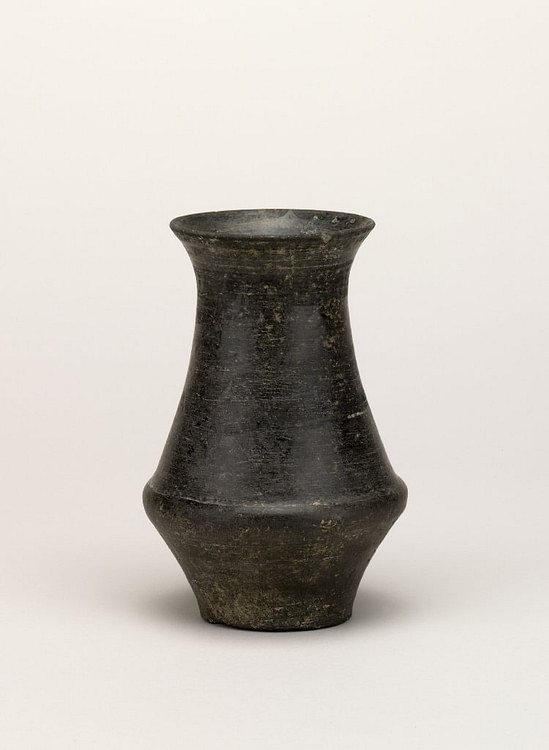
The Longshan culture (aka Lung-shan) flourished in parts of late Neolithic northeast China during the third millennium BCE and was an important link in the development of Chinese civilisation from the independent neolithic communities to the first dynastic states. The culture is named after the Longshan site in Shandong province, but it is also sometimes called the Black Pottery culture after the distinctive pottery wares it produced. Tombs, fortifications, and the discovery of a solar observation platform indicate a sophisticated society with several distinct levels. By around 1700 BCE the culture had morphed with other regional cultures into a wider Chinese Bronze Age culture.
DEVELOPMENT & CHARACTERISTICS
The Longshan culture developed from the early Dawenkou tradition, also in Shandong province, from around 3000 BCE, and would then replace the well-established Yangshao culture in northern and central China. By the first quarter of the 2nd millennium BCE the Longshan culture, after experiencing some centuries of population decline for as yet unknown reasons, began to evolve into the Bronze age culture which would eventually form the Shang dynasty (c. 1600-1046 BCE).
THE LONGSHAN CULTURE THRIVED ON AGRICULTURE, MAKING GOOD USE OF THE FERTILE SOIL OF THE YELLOW RIVER BASIN.
The period of the 3rd millennium BCE saw an increase in social interaction between small regional units and the eventual development of settlements with defined social or political hierarchies. These occurred not only in relation to the Longshan culture as recent discoveries further afield indicate that across China similar developments were occurring. There is then evidence of local interaction between such settlements with each still operating as an independent chiefdom. The existence of a state apparatus connecting villages is still many centuries away. The Longshan culture thrived on agriculture and especially the cultivation of millet, making good use of the fertile soil of the Yellow River basin. Evidence of tool use includes the presence of spades and sickles. One of the most important of the Longshan sites is Hougang, but more than ten other major sites and many more lesser ones have been identified spread over the Henan, Shandong, and Shanxi provinces.
Many Longshan sites are notable for their packed earth walls, a new archaeological feature which indicates the presence of a more sophisticated social system than seen in the Yangshao culture. One example at the Pingliangti site has a wall which encloses a space of 34,000 square metres. The wall has two gates, one on the north and another on the south side. The walls at the site of Chengziya, the earliest to be built, were on average 6 metres high. These walls and finds of arrowheads and spearheads at Longshan sites strongly suggest that the culture had to defend itself more vigorously than other contemporary cultures elsewhere in China. The necessary defence against outsiders was also likely a factor in the development of a strong sense of cultural identity and unity.
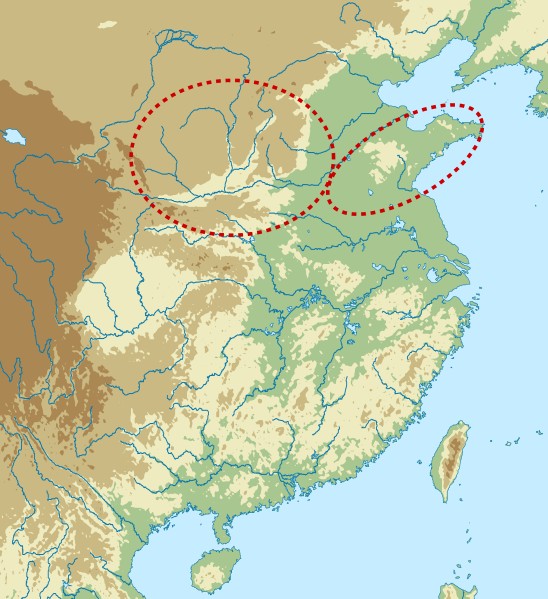
Longshan Culture Territory, China
The frequent raised mounds within the walls at Longshan settlements and the presence of dwellings outside its perimeter suggest that only the elite residences were thus protected. At the even larger site of Taosi, which dates to 2600-2000 BCE, the wall encloses some 2.8 million square metres. Taosi includes cave and semi-subterranean dwellings, as well as a wall-enclosed cemetery. Although all tombs are located in the same ground, they indicate at least three distinct social levels.
BLACK POTTERY
The black pottery produced by the Longshan is known for its glossy sheen and a general absence of decoration. The discovery of this distinctive pottery in the 1930s CE helped archaeologists to first become aware of the Longshan as a Neolithic culture distinct from the Yangshao with its red-brown pottery. Not all Longshan wares are black, as grey and also white examples exist. The fineness and extremely thin walls of the finished product is evidence of the use of the potter's wheel and professional pottery skills.
Longshan potters seemed to have concentrated on the form of vessels, which are extraordinarily varied and different from anything seen elsewhere. However, some do have decoration in the form of simple incised and impressed designs in the form of geometric patterns and sometimes animal masks. The most common shapes are jugs with pouring spouts, tall stemmed cups, handled cups, slim beakers, and tripod bowls with hollow legs which were used to heat liquids or as steamers. The fact that the vast majority of black pottery wares have been found in elite tombs and not in residential areas suggests that they were reserved for use by the elite only and then probably for ritual purposes rather than everyday use.
LONGSHAN ARTEFACTS
The excavated tombs at Longshan sites can be categorised into three types based on the number and value of the goods deposited within them. The minority (around 10%) measure some 3 x 2 metres and contain around 100 artefacts. The deceased in these tombs were placed inside a wooden coffin; sometimes there is more than one occupant per tomb. The middle group, also containing a wooden coffin, have between 20 and 30 artefacts. The last and most numerous group are mere pits and do not have the deceased in a coffin or any goods buried with them.
Besides many examples of the pottery described above, Longshan tomb artefacts include carved jades in the form of cong(squares with a cylindrical inner part which are of unknown use or significance), flat axe blades and rectangular tablets - both with a single pierced hole; painted wooden vessels; and imported luxury goods in the form of ivories, alligator skin drums, and turtle shells. Many Longshan tombs contain the skeletons of pigs or only their skulls and mandibles. These animals were probably sacrificed as part of the burial ritual and indicated wealth and/or social rank (the richer the tombs the great the number of pig remains). In addition, there are traces of perishable objects which have no longer survived but their impression has been left in the soil of tombs, notably basketwork.
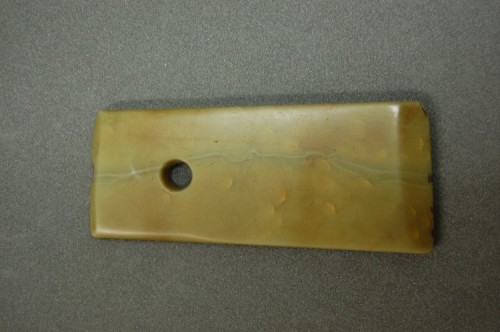
Longshan Jade Blade
Additional finds such as a copper bell, bronze vessels, and engraved metal shards indicate that the Longshan were accomplished metalworkers. The presence of copper ore and slag indicate such goods were manufactured locally and not imported. The bell was made using a clay mould, an advanced technology for the period. Finally, finds of so-called oracle bones, actually burned animal shoulder blades, indicate the practice of scapulimancy - that is the reading of cracks in the bone caused by fire, which diviners would interpret with relevance to future events.
SOLAR OBSERVATORY
The Taosi site is particularly noteworthy for its solar observatory, constructed in the mid-3rd millennium BCE and one of the oldest of its kind anywhere. Discovered in 2003 CE, the observatory consists of three circular platforms, one on top of the other, with each having a rammed earth wall. The whole is surrounded by another earth wall measuring some 50 metres in diameter. The top platform, with a diameter of 24.5 metres, has a wall which includes 13 square pillars. The spaces between these columns acted as sight lines for solar observation from a centrally-placed platform. Experimentation indicates the observatory was used particularly during the summer and winter solstices and was probably used to create an accurate solar and lunar calendar. Such record keeping may also indicate the presence of an early writing system, an idea partially supported by the presence of ordered markings on Longshan pottery shards.
Daigoji › Ancient History
Definition and Origins
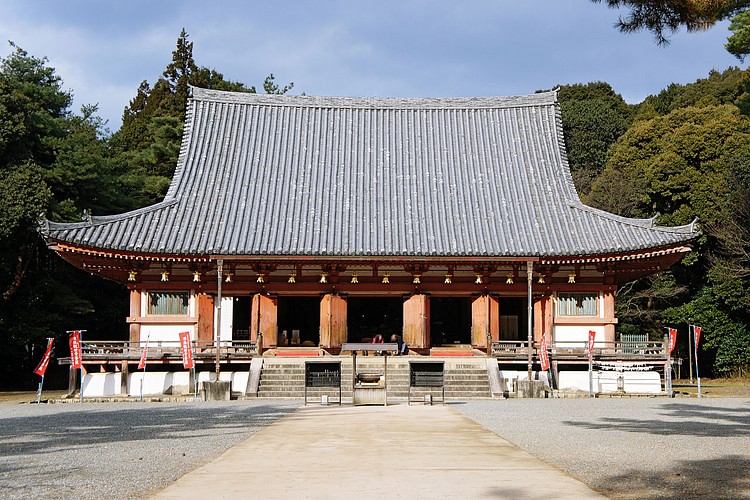
Daigoji is a Shingon Buddhist temple complex in Kyoto (ancient Heiankyo ), Japan, which was founded in 874 CE by the scholar monk Shobo (aka Rigen Daishi). The site established close ties with the imperial family and became an important place of pilgrimage. The famous pagoda of Daigoji is the oldest building in Kyoto. The temple complex has 70 wooden structures, 18 National Treasures of Japan and is a UNESCO World Heritage Site.
A ROYAL TEMPLE
Daigoji is one the head temples of the Shingon Buddhist sect and is located in southern Kyoto in an area which was once on the outskirts of the capital of Japan, Heiankyo. Here the monk Shobo, posthumously known as Rigen Daishi (Great Master of Holy Treasures), received a vision by a natural spring and so he built a simple hermitage for himself in 874 CE and the first temple later in the 9th century CE. The monastery received the backing of Emperor Daigo (r. 897-930 CE), and in 919 CE he decreed that only monks descended from Shobo's family line could hold the position of Lord Abbot. More importantly, the abbot would acquire the rank of zasu, which put him on an equal footing with the abbots of the other great monasteries of Japan: Enryakuji and Kongobuji. The complex would enjoy further imperial support over the next century which saw the site expand and benefit from an exemption from tax.
THE STAR ATTRACTION & SYMBOL OF DAIGOJI, IS THE FIVE-ROOFED PAGODA, KYOTO'S OLDEST BUILDING.
A new round of building occurred from 1115 CE under the auspices of the Lord Abbot Shokaku when the Sambo-in area was developed and the landscape gardens built. By the end of the 12th century CE, the complex had become a major centre of learning and boasted five subtemples, the Daigoiji gomonzeki (Five Aristocratic Temples of Daigoji), 42 main halls, four pagodas, three royal villas, and 183 dormitories for monks.
KAMI DAIGO
The Daigoji complex is divided into two distinct areas: the Shimo Daigo (Lower Daigo) and Kami Daigo (Upper Daigo), the latter also being the name of the mountain on whose wooded slopes it is built. The upper precinct is the site of the original temple founded by Shobo. One of the most important structures in the Kami Daigo is the Yakushido Hall. Today's version was built in 1121 CE, and it contains ancient artworks which include an image dating to 907 CE when the original building was constructed. The spring which convinced Shobo to build on the site is now enshrined in its own wooden enclosure.

Daigoji Pagoda, Kyoto
SHIMO DAIGO
Nestling at the base of the mountain, 4.5 km (2.5 miles) from the Kami Daigo, the lower precinct was developed from 926 CE, when the site received imperial patronage, and includes the massive Main Golden Hall (Kondo) with its impressive sloping roof which dates to the Kamakura Period (1185-1333 CE). Here, too, are the Sambo-in or Monastery of the Three Treasures (first built in the 12th century CE), the Imperial Messenger Gate (not actually used as a gate), and gardens famous for their cherry blossoms, the Benten Pond with its wooden bridge and shrine, and the site's museum. Also architecturally significant are the Front Reception Hall ( Omote- shoin ) and the Inner Reception Hall ( Oku- shoin ) which are examples of 16th-century CE domestic buildings in the shoin - zukuri style. Inside both buildings, the walls and sliding paper screens ( fusuma ) are painted with landscape pictures.
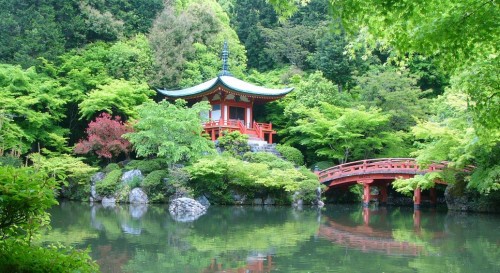
Benten Pond, Daigoji
LATER HISTORY
As with many other ancient buildings in Japan the site suffered its fair share of destruction, both deliberate and accidental, especially during the Onin War (1467-1477 CE). Toyotomi Hideyoshi, the 16th-century CE imperial regent, restored the site's main temple and beautified the Sambo-in gardens. According to the diary of Gien, the abbot at the time, Hideyoshi personally landscaped the gardens to his own liking, bringing in 700 large stones for the purpose which he selected for their unusual shape and then placed for a maximum aesthetic effect. Many stones were pinched from other scenic sites across Japan, and some even came from his own pleasure palace, the splendidly named Mansion of Collected Luxuries or Juraku-dai. Since Hideyoshi's efforts, many of the other buildings at Daigoji have been similarly restored.
Today Daigoji is still a working temple and monastery, the upper precinct continues to be a place where monks practise asceticism ( Shugendo ), and it remains a passage on major pilgrimage routes. As a UNESCO World Heritage Site since 1994 CE and home to many important ancient buildings and artworks Daigoji is, of course, also popular with tourists, especially those keen to see each spring the celebrated cherry blossoms of the Sambo-in gardens.
This article was made possible with generous support from the Great Britain Sasakawa Foundation.
LICENSE:
Article based on information obtained from these sources:with permission from the Website Ancient History Encyclopedia
Content is available under License Creative Commons: Attribution-NonCommercial-ShareAlike 3.0 Unported. CC-BY-NC-SA License